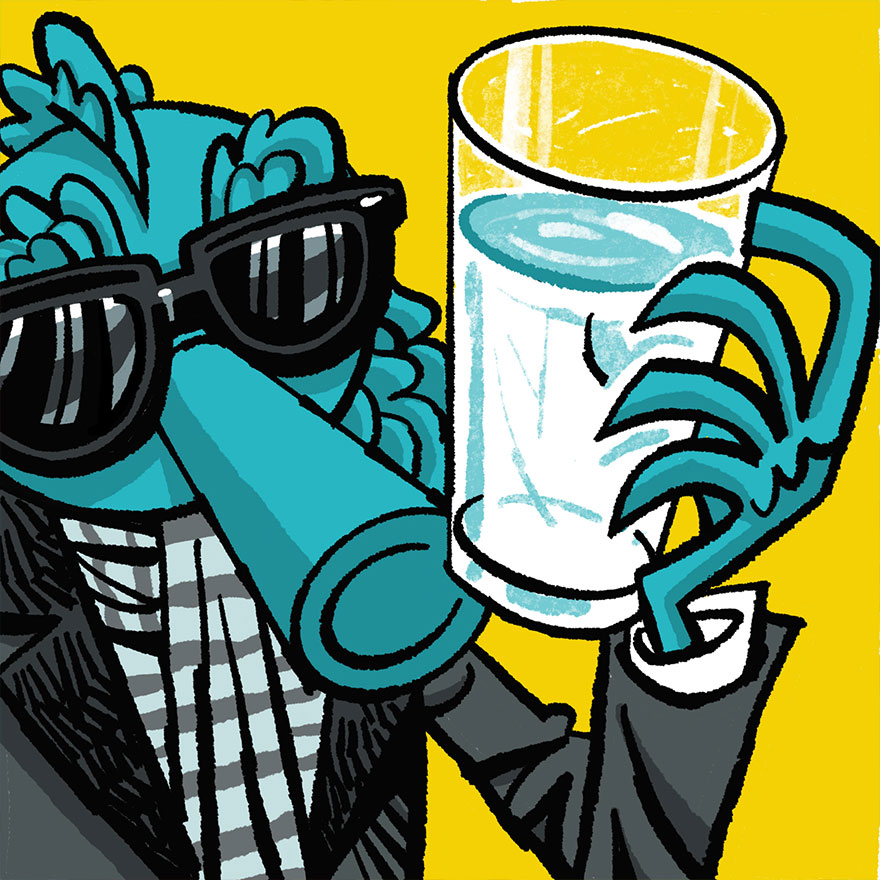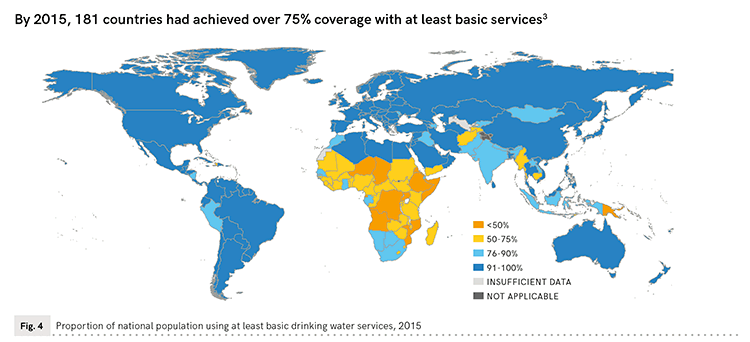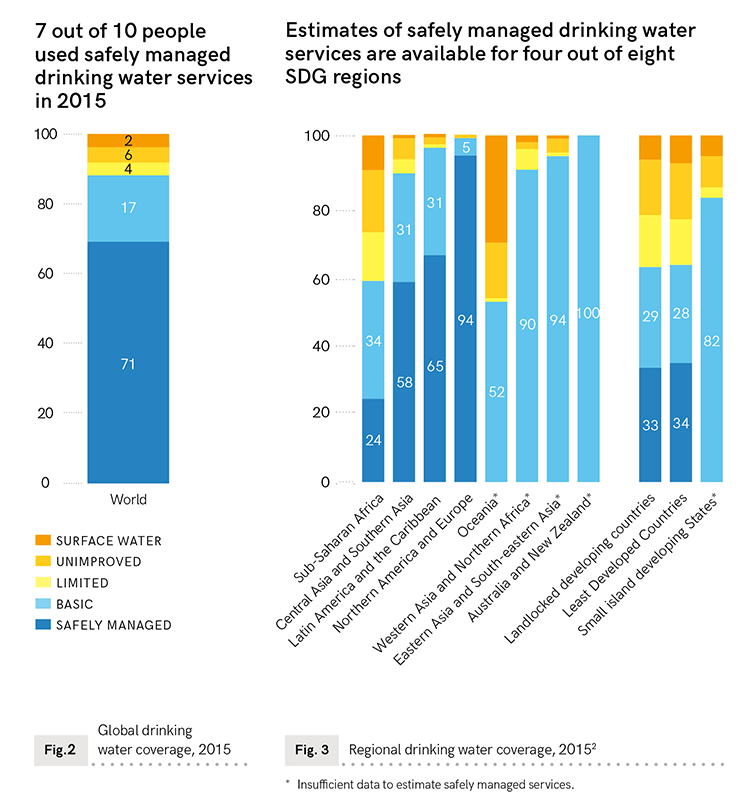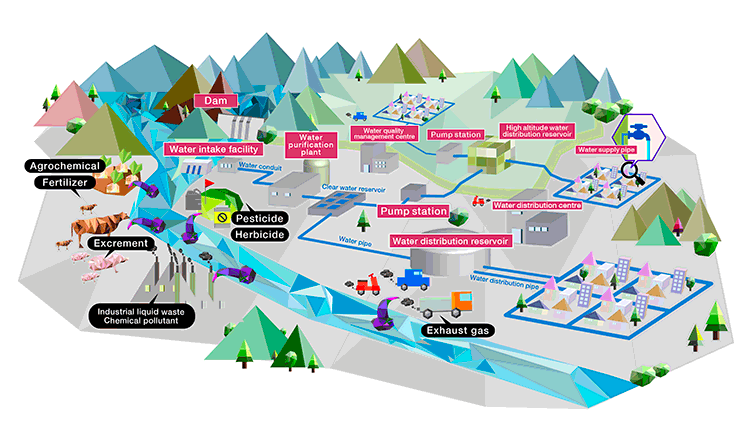MISSION 04

ABOUT
1 out of 3 people(2.2 billion people)in this world don’t have access to clean drinking water.
97.5% of water on the Earth is saltwater, while only 2.5% is freshwater.
Most of the freshwater is water in the ice or soil of Antarctica and Greenland or underwater from deep underground. The water amount left for Earthlings to use daily is only 4 % of all freshwater, and this water is more precious than you think.
While the Earthlings must have clean water to survive(*1), they continue to pollute the remaining 4 percent of water available for their daily lives. The water is affected by various substances as it travels from the source to everyone’s home. For example, chemical fertilizers and agrochemicals used in farmlands and golf courses, industrial liquid waste, dry cleaning solvents, and those harmful chemical substances that are unremovable even at purification plants, are dissolved in the groundwater and eventually contaminate the drinking water. Did you know about these facts? Sewage drained into rivers, lakes, and oceans have a negative impact on not only the creatures there, but also on the bodies of humans and animals that eat them. A human or an animal that drinks sewage water may suffer from disease or lose their lives at worst. The most significant contamination factor is domestic wastewater. Water discharged from bath, laundry, and especially the kitchen is a cause for serious water pollution.
*1… What is “clean water”?
Citing: Bureau of Waterworks Tokyo Metropolitan Government’s website. Water Source and Quality Criteria.
Citing: Ministry of Land, Infrastructure, Transport and Tourism’s website. Water Quality Investigation Through Aquatic Life.

Citing: Progress on Drinking Water, Sanitation and Hygiene: 2017 Update and SDG Baselines. Geneva: World Health Organization(WHO)and the United Nations Children’s Fund(UNICEF), 2017.
Licence: CC BY-NC-SA 3.0 IGO.
PROBLEM
What is the Impact of the Water Crisis on Us?
The water the Earthlings use in their everyday lives is reused. Discharged water from homes and factories goes down drains, then gets purified to return to rivers and oceans. Part of the water evaporates to form clouds, becomes rain and accumulates in dams. Dust and dirt are removed through a water purification process and the water returns to the rivers and the sea. To purify the dirty water, a vast amount of energy is required. CO2 is emitted in the purification process,
which contributes to global warming.
It is also said that 2.2 billion people around the world(the world population is about 8 billion as of 2020), do not have access to clean water. That is nearly one in three people. In many developing countries, “fetching water" is considered a job for children and women, and many spend a large part of their days on this difficult task. If those people have easier access to water, the children might be able to go to school and women will have a variety of job opportunities. The water crisis has a significant impact, not only on human lives, but also on education and economy. The widely recognised problem of water pollution can be stopped with just a little action.

Citing: Progress on Drinking Water, Sanitation and Hygiene: 2017 Update and SDG Baselines. Geneva: World Health Organization(WHO)and the United Nations Children’s Fund (UNICEF), 2017.
Licence: CC BY-NC-SA 3.0 IGO.
ACTION
Basic Actions in Daily Life
Try not to release “organic matter” in the domestic wastewater(laundry, bath, and especially kitchen)as much as possible
Learn how much water is needed to purify wastewater
Citing: Tokyo Metropolitan Government Bureau of Environment. Domestic Wastewater Measures
Bath
Do not keep the water running constantly when taking a shower
Do not drain the bathwater after a single use
Reuse it for laundry, cleaning, etc.
Reduce the amount of hot water in the bath
Use shampoo and conditioner as little as possible
Avoid letting hair go down the drain
Toilet
Do not flush anything except toilet paper
Take care to differentiate between the “big flush” and “small flush” buttons and use as needed
*The water use difference between the two is equivalent to 2 plastic bottles of water
Cooking
Do not throw leftovers and food wastedown the drain
When you cook liquids such as soup, only cook as much as needed and avoid excess leftovers
Do not dispose of oils down the drain(Wipe grease out with paper, etc. before washing)
Throw food waste in a drainer bag
Use it in combination with sink strainers too(45% more waste can be removed than without it)
Make effective use of rice water, vegetable boiling water, etc.
(For washing dishes, watering plants, and so on)
Laundry/ Washing
Use an appropriate amount of laundry detergent
Do not use a large amount
Use a one rinse cycle for laundry
Wash as many clothes as possible at one time
Use the remaining bath water for laundry(This also has the advantage that soils and stains can be easily removed)
If clothing is excessively dirty, wash them by hand
Use a lint filter in the washing machine
Use laundry net bags
Do not leave water running while washing dishes
Use a dishwasher
When washing clothes and dishes, use “highly biodegradable detergents” that are decomposed into inorganic matters by the biological purification of rivers and oceans
Do not use too much detergent
Citing: Chemical Management Center, Reference: National Institute of Technology and Evaluation.
Chemical substances in our everyday use products
Others
Do not leave water running while washing your face or brushing your teeth
©THE MISTRESS 5 all rights reserved. Unauthorized reproduction prohibited.






